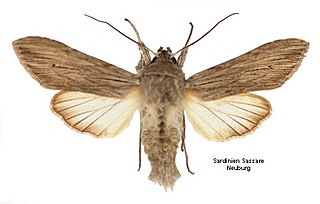
The Noctuidae, commonly known as owlet moths, cutworms or armyworms, are a family of moths. They are considered the most controversial family in the superfamily Noctuoidea because many of the clades are constantly changing, along with the other families of the Noctuoidea. It was considered the largest family in Lepidoptera for a long time, but after regrouping Lymantriinae, Catocalinae and Calpinae within the family Erebidae, the latter holds this title now. Currently, Noctuidae is the second largest family in Noctuoidea, with about 1,089 genera and 11,772 species. However, this classification is still contingent, as more changes continue to appear between Noctuidae and Erebidae.

Cucullia is a genus of moths of the family Noctuidae. The genus was erected by Franz von Paula Schrank in 1802.
Haemerosia is a genus of moths of the family Noctuidae. The genus was erected by Jean Baptiste Boisduval in 1840.

The false water betony is a moth of the family Noctuidae. It is found from south-eastern France, through the Alps and bordering mountains east to Romania and Bulgaria. It is also found in Anatolia and Lebanon.

Cucullia tanaceti is a moth of the family Noctuidae. The species was first described by Michael Denis and Ignaz Schiffermüller in 1775.

Cucullia praecana is a moth belonging to the family Noctuidae. The species was first described by Eduard Friedrich Eversmann in 1844.




